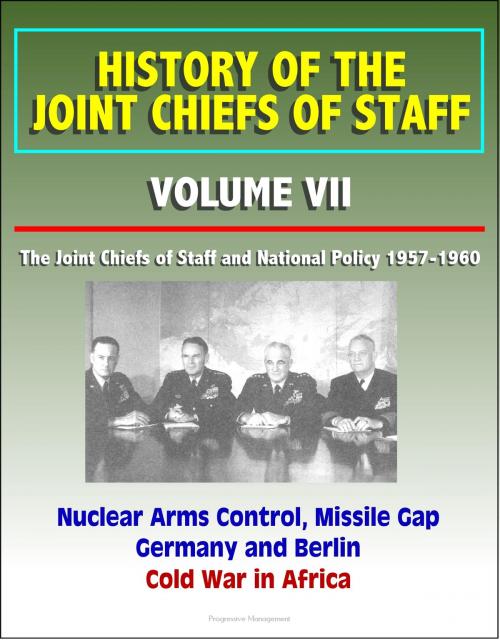History of the Joint Chiefs of Staff: Volume VII: The Joint Chiefs of Staff and National Policy 1957-1960 - Nuclear Arms Control, Missile Gap, Germany and Berlin, Cold War in Africa
Nonfiction, History, Military, United States| Author: | Progressive Management | ISBN: | 9781301013043 |
| Publisher: | Progressive Management | Publication: | September 21, 2013 |
| Imprint: | Smashwords Edition | Language: | English |
| Author: | Progressive Management |
| ISBN: | 9781301013043 |
| Publisher: | Progressive Management |
| Publication: | September 21, 2013 |
| Imprint: | Smashwords Edition |
| Language: | English |
Volume VII describes JCS activities during the period 1957-1960 except for activities related to Indochina which are covered in a separate series. Although only the names of its principal authors appear on the title page, the preparation of Volume VII was truly a collaborative effort. Originally written in the 1960s, the classified publication had thirteen chapters.
From forty years' perspective, the second Eisenhower administration's record in national security affairs seems better than many rated it at the time. The danger posed by a "missile gap" was countered without resorting to massive expenditures. Threats to West Berlin and to the "offshore islands" of Quemoy and Matsu were mastered by relatively low-key responses. An intervention in Lebanon was short and successful. Cuba, the Congo, and Southeast Asia remained volatile, however, and all were approaching crisis states by January 1961.
The antagonism between the United States and the Soviet Union, which had come to seem permanent and implacable, dominated the international scene as President Dwight D. Eisenhower entered his second term of office in January 1957. Lack of success in solving such persistent problems as the arms race and the division of Germany, inability to prevent what looked like communist fishing in troubled waters, and the apparently irresistible momentum of the Cold War had taken on more menacing aspects as both superpowers acquired sizable nuclear arsenals. At the time of President Eisenhower's second inauguration, there still remained threatening repercussions from the Hungarian revolt and the Suez crisis. For many people, however, the implications of an emerging "balance of terror" had become the overriding concern. Peace seemed to depend upon each superpower possessing the ability to destroy the other.
-
Working the Machinery of Government * 2. Backing Away from "Massive Retaliation" * 3. Budget Ceilings Shape Force Levels * 4. Closing the "Missile Gap" * 5. Arms Control: The Moratorium on Nuclear Testing * 6. Maintaining the Military Assistance Program * 7. NATO Emphasizes Nuclear Capabilities * 8. Germany and Berlin * 9. The Middle East: Implementing the Eisenhower Doctrine * 10. The Middle East: Lebanon and After * 11. What Role for CENTO? * 12. Cuba Becomes a Communist State * 13. The Cold War Comes to Africa * 14. The Far East: Holding the Line * 15. The Far East: Fissures in Containment * 16. Conclusion
-
Working the Machinery of Government * An Experienced Team * The Structure of Decisionmaking * The Defense Reorganization Act of 1958 * The Joint Program for Planning * 2. Backing Away from "Massive Retaliation" * Emphasizing a Nuclear Response * No Change of Course * A Nonnuclear Conflict Becomes Conceivable * A Final Revision * 3. Budget Ceilings Shape Force Levels * 1957 * 1958 * 1959 * 1960 * Conclusion * 4. Closing the "Missile Gap" * The "Sputnik" Supplemental * Setting Program Priorities * Achievements Exceed Expectations * The Single Integrated Operational Plan * 5. Arms Control: The Moratorium on Nuclear Testing * The Linkage Issue * Separating the Testing Issue * The Decision to Suspend Testing * The "Threshold" Debate * The Bubble Bursts * Summation * 6. Maintaining the Military Assistance Program * 1957 * 1958 * 1959 * 1960 * Conclusion * Major Force Objectives * 7. NATO Emphasizes Nuclear Capabilities * A New Strategic Concept * Cutbacks in Conventional Commitments? * MC-70 Sets Slightly Lower Force Goals * Cutting Back the US Commitment? * A Nuclear Arsenal for NATO * Origins of the Multilateral Force * 8. Germany and Berlin * US Objectives Remain Unchanged * Reacting to the Rapacki Plan * Focusing on Prevention of Surprise Attack * Challenge over Berlin * 9. The Middle East: Implementing the Eisenhower Doctrine * Limitations of the Eisenhower Doctrine * Planning to Meet Aggression * Accenting the Political Dimension * Aiding Iraq and Jordan * Losing Bases in Morocco
Volume VII describes JCS activities during the period 1957-1960 except for activities related to Indochina which are covered in a separate series. Although only the names of its principal authors appear on the title page, the preparation of Volume VII was truly a collaborative effort. Originally written in the 1960s, the classified publication had thirteen chapters.
From forty years' perspective, the second Eisenhower administration's record in national security affairs seems better than many rated it at the time. The danger posed by a "missile gap" was countered without resorting to massive expenditures. Threats to West Berlin and to the "offshore islands" of Quemoy and Matsu were mastered by relatively low-key responses. An intervention in Lebanon was short and successful. Cuba, the Congo, and Southeast Asia remained volatile, however, and all were approaching crisis states by January 1961.
The antagonism between the United States and the Soviet Union, which had come to seem permanent and implacable, dominated the international scene as President Dwight D. Eisenhower entered his second term of office in January 1957. Lack of success in solving such persistent problems as the arms race and the division of Germany, inability to prevent what looked like communist fishing in troubled waters, and the apparently irresistible momentum of the Cold War had taken on more menacing aspects as both superpowers acquired sizable nuclear arsenals. At the time of President Eisenhower's second inauguration, there still remained threatening repercussions from the Hungarian revolt and the Suez crisis. For many people, however, the implications of an emerging "balance of terror" had become the overriding concern. Peace seemed to depend upon each superpower possessing the ability to destroy the other.
-
Working the Machinery of Government * 2. Backing Away from "Massive Retaliation" * 3. Budget Ceilings Shape Force Levels * 4. Closing the "Missile Gap" * 5. Arms Control: The Moratorium on Nuclear Testing * 6. Maintaining the Military Assistance Program * 7. NATO Emphasizes Nuclear Capabilities * 8. Germany and Berlin * 9. The Middle East: Implementing the Eisenhower Doctrine * 10. The Middle East: Lebanon and After * 11. What Role for CENTO? * 12. Cuba Becomes a Communist State * 13. The Cold War Comes to Africa * 14. The Far East: Holding the Line * 15. The Far East: Fissures in Containment * 16. Conclusion
-
Working the Machinery of Government * An Experienced Team * The Structure of Decisionmaking * The Defense Reorganization Act of 1958 * The Joint Program for Planning * 2. Backing Away from "Massive Retaliation" * Emphasizing a Nuclear Response * No Change of Course * A Nonnuclear Conflict Becomes Conceivable * A Final Revision * 3. Budget Ceilings Shape Force Levels * 1957 * 1958 * 1959 * 1960 * Conclusion * 4. Closing the "Missile Gap" * The "Sputnik" Supplemental * Setting Program Priorities * Achievements Exceed Expectations * The Single Integrated Operational Plan * 5. Arms Control: The Moratorium on Nuclear Testing * The Linkage Issue * Separating the Testing Issue * The Decision to Suspend Testing * The "Threshold" Debate * The Bubble Bursts * Summation * 6. Maintaining the Military Assistance Program * 1957 * 1958 * 1959 * 1960 * Conclusion * Major Force Objectives * 7. NATO Emphasizes Nuclear Capabilities * A New Strategic Concept * Cutbacks in Conventional Commitments? * MC-70 Sets Slightly Lower Force Goals * Cutting Back the US Commitment? * A Nuclear Arsenal for NATO * Origins of the Multilateral Force * 8. Germany and Berlin * US Objectives Remain Unchanged * Reacting to the Rapacki Plan * Focusing on Prevention of Surprise Attack * Challenge over Berlin * 9. The Middle East: Implementing the Eisenhower Doctrine * Limitations of the Eisenhower Doctrine * Planning to Meet Aggression * Accenting the Political Dimension * Aiding Iraq and Jordan * Losing Bases in Morocco















